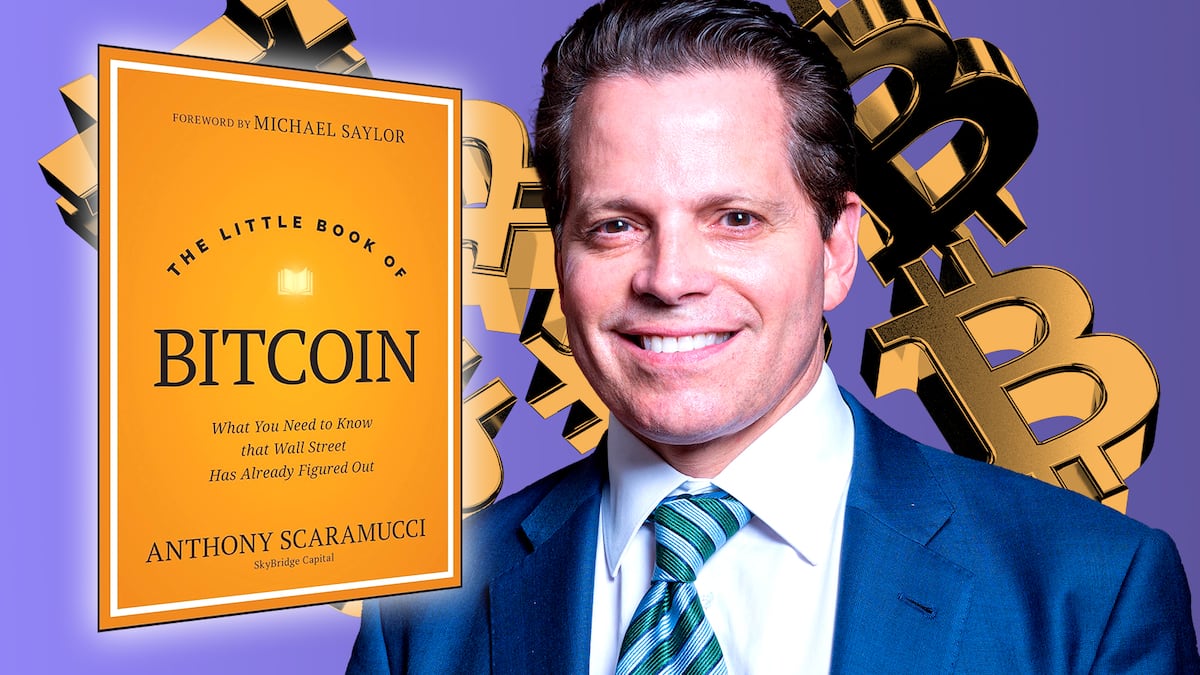- How did institutions finally get Bitcoin?
- Anthony Scaramucci’s new book breaks it down.
- And he sells the finance industry on it.
- Here's where he misses the mark.
Ekin Genç is DL News’ managing editor. Opinions expressed are his own.
Anthony Scaramucci’s new book wants to be the definitive, normie-friendly introduction to Bitcoin — something you can hand to both a finance pro or your sceptical uncle who heard about Bitcoin on Facebook.
And in some ways, it succeeds.
“The Little Book of Bitcoin: What You Need to Know that Wall Street Has Already Figured Out” is a smooth, engaging read, packed with stories of billionaires, hedge fund heavyweights, and Wall Street bigwigs who “finally got it.”
Scaramucci is the founder and managing partner of SkyBridge Capital, an asset manager in New York.
He’s best known for his brief tenure as White House communications director during Donald Trump’s first term — a role that lasted 11 days.
At about 200 pages and 17 bite-sized chapters, Scaramucci’s book is a fast, skimmable read packed with name-dropping, soundbites and quick investment insights.
Scaramucci keeps it tight, persuasive, and Wall Street-friendly. He knows how to tell a story.
“I’m a nouveau riche Italian from Long Island. I grew up with no money,” Scaramucci told DL News in December, sipping coffee in the lobby of the Four Seasons Hotel in Abu Dhabi.
“My life’s dream is to have a Lamborghini.” He bought that new lambo, he said, because crypto markets are soaring — but he didn’t buy it with crypto.
“Why would I fucking sell my Bitcoin?”
That same sharp, self-assured energy runs through “The Little Book of Bitcoin.”
Scaramucci opens the book with a solid case for Bitcoin and effortlessly outlines his case before shifting to Wall Street’s growing embrace.
He presents Bitcoin as a market disruptor, much like Amazon and Apple revolutionised their respective industries.
“Bitcoin is Netflix. Bitcoin is the iPhone. Bitcoin is the inevitable pull of progress that will level everything in its wake. You either ride that wave or get ridden,” he writes.
He finds it frustrating that some, including Kevin O’Leary, didn’t “get” Bitcoin even though the Canadian entrepreneur is an “avid Rolex collector, so he understood how stores of value worked.”
“Sometimes, we make investing – and life, for that matter – much harder than it needs to be. Sometimes, the answer is staring you right in the face,” Scaramucci writes.
He wonders what took him and other late Bitcoin bloomers so long. He chalks it up to “the bottom-up nature of its ascent.”
Scaramucci’s stance contrasts with those known in the industry as “maxis,” or maximalists.
They’re ideologically allured by Bitcoin — not just as a trade but as a technological and financial revolution — and may find Scaramucci’s take frustrating at times.
They’ll probably see him as too focused on making Bitcoin palatable to Wall Street, too caught up in institutional adoption, and too unwilling to engage with the deeper questions that they, and many other Bitcoiners, care about.
Yet Scaramucci alludes to them only in the context of capital allocation.
Maxis believe there is no need to own anything else, he writes.
“By their logic, it’s silly to own a slice of the future and commit anything less than 50% of their available capital.”
That’s extreme even for Scaramucci, who recommends a 2% allocation to Bitcoin for beginners, and at least 10% to those who are more risk averse.
Always great to spend time with the living legend @saylor. Grateful for you writing the foreword to my latest book, The Little Book of #Bitcoin pic.twitter.com/H3wg1a0ED6
— Anthony Scaramucci (@Scaramucci) September 12, 2024
A common refrain in the book is Scaramucci’s name-dropping and anecdotes, making you feel like you’re eavesdropping on the VIP section at a finance conference.
He presents some insider moments, but it’s not always clear how many of those anecdotes come from his personal experiences, and how many are just industry soundbites repackaged for narrative effect.
Ethereum gets only a fleeting mention. In an anecdote about Mike Novogratz, founder and CEO of crypto investment firm Galaxy Digital, Novogratz seeks crypto advice from his old college roommate, Joe Lubin, Ethereum co-founder and CEO of ConsenSys.
Yet, Scaramucci barely lingers on that moment.
Scaramucci credits MicroStrategy founder Michael Saylor for his influence on his love of Bitcoin.
Scaramucci recounts a pivotal Zoom conversation with Saylor during the pandemic, facilitated by Peter Briger, a Fortress partner and early Bitcoin adopter.
Despite his strong belief in Bitcoin, Scaramucci doesn’t exhibit the near-religious conviction of Saylor, one of Bitcoin’s most vocal evangelists.
Institutions that Scaramucci talks about in the book are in Bitcoin for the trade, not as ideological believers.
After all, banks see dollar signs via arbitrage, derivatives, and ETF fees, and are less interested, to say the least, in overthrowing the finance system through some sort of decentralised technology.
“There’s a strange irony to Bitcoin’s journey through the financial system. It was started by computer scientists, libertarians, and anarchists to create a form of money that existed outside the established financial construct,” Scaramucci writes.
“But to achieve its full potential, to truly become a global form of digital value, it needed to be inserted and integrated into the financial services industry.”
What Scaramucci should perhaps emphasise more is that, unlike traditional financial assets, Bitcoin remains largely beyond Wall Street’s control.
Bitcoin’s creator Satoshi Nakamoto designed it to remove the need for intermediaries — anyone, anywhere can send Bitcoin, run a node, and verify transactions without needing approval from any institution.
Even as Wall Street creates derivatives and ETFs around Bitcoin, it doesn’t control access to the network itself.
Unlike traditional finance, where dominant players influence supply and shape market rules through lobbying and regulatory capture or influence monetary supply through credit expansion, Bitcoin’s core protocol operates independently of their influence.
There will only ever be 21 million Bitcoin.
So perhaps the real and more fascinating shift isn’t just that Wall Street is buying in — it’s that, for once, it has to play by someone else’s rules.
That’s fair criticism about fiat money, you might think, but what about gold?
“Older libertarians may flock to gold as a hedge against the end of the world, against societal collapse, and to some extent, many Bitcoin investors buy the cryptocurrency for the same reasons,” Scaramucci writes.
“But in the exceedingly rare chance that society does collapse, would you rather be walking around with a bag of gold bars or with a completely traceable store of value on your phone?”
“For a generation that grew up using computers,” Scaramucci concludes, “the answer is easy.”


